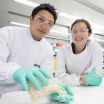(Press-News.org) A research team bringing together José Cohen and Philippe Grimbert (Inserm Unit 955/Université Paris Est Créteil [UPEC] and the Centre for Clinical Investigation - Biotherapies 504 [CIC-BT 504]), and their collaborators at Institut Curie and AP-HP (George Pompidou European Hospital) has succeeded in finding a combination of drugs that reduces the risk of rejection following a skin graft. When tested in mice, this treatment seems effective, since no sign of rejection is observed nearly 30 days after transplantation.
These results are published in the American Journal of Transplantation.
For physicians and researchers, a major challenge of transplantation is avoiding rejection of the transplanted organ or tissue by the recipient's body. During allogeneic transplantation (i.e. of a graft from donor A into a different recipient, B), the immune system of the recipient recognises the graft as a foreign component. It then makes every effort to destroy it in the same way as it would, for example, destroy an infecting virus. To avoid this phenomenon, physicians administer immunosuppressive drugs to make the recipient's immune system more tolerant. As with every treatment, there are drawbacks: the recipient's vulnerability to infections is increased, and the treatment may have toxic effects on other organs (kidney). For the last 30 years, there has been little progress in this area of research. The optimisation of these treatments is therefore central to the current efforts.
Inserm researchers under the leadership of José Cohen became interested in a drug with special properties, namely the cytokine interleukin 2 (IL-2). This drug is already used in some treatments for cancer and type 1 diabetes. In cancer, administration of IL-2 in high doses increases antitumour activity by boosting the immune system. Interestingly, Eliane Piaggio, a co-author of this study, had shown that when administered at very low doses in type 1 diabetes, it has the opposite effect. IL-2 thus impedes the action of the immune system, which reacts too strongly against self in this disease.
Given that, in transplantation, the immune response is too strong, the researchers hypothesised that administration of IL-2 might impede the action of the immune system (by analogy with its action in type 1 diabetes), and might therefore reduce graft rejection.
"Our initial experiments proved negative: IL-2 used alone did not give the expected results," explains José Cohen. "We had to redirect our efforts and our attention to the specific functioning of 2 types of cells from the immune system, namely the regulatory T lymphocytes controlled by IL-2, and the "classical" T lymphocytes."
The immune system is composed of several categories of cells, each with a specific role in maintaining its balance: it must not be too aggressive or too tolerant. Generally, regulatory T lymphocytes, as their name indicates, act on the other populations of classical T lymphocytes to prevent them from over-reacting. Hence the initial idea of boosting their activity via IL-2. However, this strategy turned out to be inadequate.
The researchers therefore used IL-2 in combination with rapamycin, which has the ability to inhibit the division of classical T lymphocytes. Using this combination, the researchers managed to doubly control the classical T lymphocytes: directly using rapamycin and indirectly using IL-2 (via the regulatory T lymphocytes). Graft rejection was thereby avoided.
"Skin grafting in mice is the most difficult experimental model to control. In our experiment, mice show no sign of rejection 30 days following a skin graft. This is very encouraging when we know that this rejection usually occurs in 10 days: the tissue becomes irreversibly necrotic."
These results are a first step before clinical evaluation. An advantage of these two drugs is that they have marketing authorisation for use in humans. If the next steps are successful, especially in the liver transplant model, their use in the area of transplantation (any kind of transplantation) might soon begin.
INFORMATION:
Sources
Administration of Low Doses of IL-2 Combined to Rapamycin Promotes Allogeneic Skin Graft Survival in Mice
C. B. Pilon1,2,3, S. Petillon1,2, S. Naserian1,2, G. H. Martin1,2, C. Badoual4, P. Lang1,2,5, D. Azoulay1,2,6, E. Piaggio7,8,9, P. Grimbert1,2,3,5,a and J. L. Cohen1,2,3,*,a
1 Faculté de Médecine, Université Paris-Est Créteil, Créteil, France
2 Institut Mondor Recherche Biomédicale (IMRB), Inserm U 955, Créteil, France
3 AP-HP, Groupe Hospitalier Henri-Mondor Albert-Chenevier, CIC-BT-504, Créteil, France
4 AP-HP, Hôpital Européen Georges Pompidou, Service D'anatomo-Pathologie, Paris, France
5 AP-HP, Groupe Hospitalier Henri-Mondor Albert-Chenevier, Service de Néphrologie, Créteil, France
6 AP-HP, Groupe Hospitalier Henri-Mondor Albert-Chenevier, Service de Chirurgie Digestive, Créteil, France
7 Inserm U932, Paris, France
8 Section Recherche, Institut Curie, Paris, France
9 Inserm Center of Clinical Investigation (CBT507 IGR-Curie), Paris, France
American Journal of Transplantation 14 novembre 2014 http://dx.doi.org/10.1111/ajt.12944
Researcher Contact
José Cohen
Inserm Unit 955/ Université Paris Est Créteil [UPEC] and the Centre for Clinical Investigation - Biotherapies 504
Tél: 01 49 81 44 75 // 06 14 82 88 13
jose.cohen@inserm.fr
Press contact
presse@inserm.fr
DALLAS - November 18, 2014 - Groundbreaking research from UT Southwestern Medical Center shows that cholesterol efflux capacity (cholesterol efflux), which measures HDL cholesterol function, appears to be a superior indicator of cardiovascular risk and a better target for therapeutic treatments than standard measurements of HDL. Current measurement methods reflect only the circulating levels of HDL and not the functional properties of this lipoprotein.
The latest findings appear online today in The New England Journal of Medicine.
HDL's key function is the removal of ...
CLEVELAND, Ohio (November 17, 2014)--Does soy in the diet help with hot flashes? It does, but only for women whose bodies can produce the soy metabolite equol, reports a study of American women just published online in Menopause, the journal of The North American Menopause Society. About 20% to 50% of North American and European women have this ability.
The researchers surveyed women from age 45 to 55 in a Seattle, Washington-area healthcare system to find study participants who weren't using hormone therapy and ate soy foods at least three times a week. The participants ...
Hiroshima, Japan--- Associate Professor Akira Shimamoto and Professor Hidetoshi Tahara at the Graduate School of Biomedical & Health Science in Hiroshima University, Professor Koutaro Yokote at the Graduate School of Medicine in Chiba University, Visiting Professor Makoto Goto at the Medical Center East in Tokyo Women's Medical University, and collaborators including the staff at the Cancer Chemotherapy Center in the Japanese Foundation for Cancer Research, Tottori University, and Keio University established induced pluripotent stem (iPS) cells from the fibroblasts of Werner ...
Chemists have developed a revolutionary new way to manufacture natural chemicals and used it to assemble a scarce anti-inflammatory drug with potential to treat cancer and malaria.
The breakthrough could lead to new and cheaper ways to produce rare drugs in large quantities.
"We took small molecules and clipped them together like Lego," said lead researcher Professor Michael Sherburn, from the Research School of Chemistry at The Australian National University (ANU).
"The building blocks are carefully designed in such a way that the first reaction generates a product ...
Scientists in Australia have used historic media to measure the decline in Queensland's pink snapper fishery, highlighting a drop of almost 90 per cent in catch rates since the 19th Century.
Researchers from the ARC Centre of Excellence for Coral Reef Studies (Coral CoE) at the University of Queensland and the Department of Agriculture Fisheries and Forestry examined thousands of newspaper articles dating back to1870 to reveal the historic catch rates for the iconic Queensland fishery.
"We found that 19th century recreational fishers would regularly catch hundreds of ...
Case Western Reserve researchers have developed a procedure that restores function to muscles involved in the control of breathing - even when they have been paralyzed for more than a year. The breakthrough offers hope that one day patients with severe spinal cord injuries will be able to breathe again without the assistance of a ventilator.
Principal investigator Philippa M. Warren, PhD, presented the results Nov. 17 at Neuroscience 2014, the annual meeting of the Society for Neuroscience. The research represents a critical step forward in efforts to reverse even long-term ...
Ferroptosis is a recently recognized form of regulated necrosis. Up until now, this form of cell death has only been thought to be a possible therapeutic approach to treat tumour cells. Yet, ferroptosis also occurs in non-transformed tissues as demonstrated by this study, thus implicating this cell death pathway in the development of a wide range of pathological conditions. More specifically, the deletion of the ferroptosis-regulating enzyme Gpx4* in a pre-clinical model results in high ferroptosis rates in kidney tubular epithelial cells causing acute renal failure.
Specific ...
The increasing complexity and interconnection of socioeconomic and environmental systems leaves them more vulnerable to seemingly small risks that can spiral out of control, according to the new study, published in the journal Proceedings of the National Academy of Sciences.
The study examines risks are perceived as extremely unlikely or small, but because of interconnections or changes in systems, can lead to major collapses or crises. These risks, which the researchers term "femtorisks," can include individuals such as terrorists, dissidents, or rogue traders, or factors ...
This news release is available in German. Scientists have been conducting research on micrometre-sized actuators which one day may make it possible to transport drugs or chemical sensor molecules to specific locations throughout the human body. Researchers at ETH Zurich have now taken the development of such micro-devices a crucial step forward: a new production technology and new materials have made it possible to manufacture tiny actuators in any form and optimise them for future applications.
The elongated actuators elements, which can move through liquids, possess ...
Melbourne researchers have identified why some people with coeliac disease show an immune response after eating oats.
The researchers have identified the key components in oats that trigger an immune response in some people with coeliac disease. The findings may lead to better tests for oat toxicity, and have implications for new treatments being developed for coeliac disease.
As many as one in 60 women and one in 80 men in Australia have coeliac disease, an autoimmune condition caused by consuming gluten, a protein found in wheat, rye and barley. The abnormal immune ...



